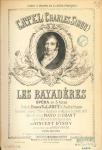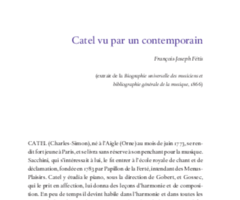
Charles-Simon CATEL
1773 - 1830
Composer
A state musician and a highly regarded teacher: such is the commonly accepted image of Catel. Originally from Normandy, he moved to Paris at the age of eleven and studied composition with Gossec. Like his teacher, he composed works for wind band and hymns written in celebration of the French Revolution. In 1795, he became professor of harmony and counterpoint at the newly founded Paris Conservatoire, of which he would later become general inspector. He contributed to the Méthodes de solfège du Conservatoire and, most importantly, wrote a Traité d’harmonie (1802). This work, which focused on practice rather than theory, was translated into several languages. Early in his career, Catel composed quartets for wind and strings (1796), string quintets (1797) and piano sonatas (1799). He then turned his attention to the theatre, with the tragédie lyrique Sémiramis (1802) and two opéras bouffons (1807): Les Artistes par occasion and L’Auberge de Bagnères. He also wrote the ballet Alexandre chez Apelles (1808) and several opéras comiques. He may not have revolutionised opera, but he certainly played a role in its development, in particular by devising extended scenes which departed from the conventional division into individual numbers. Additionally, Les Bayadères (1810), whose action is set in India, marks a transition towards grand opera; and Wallace ou Le Ménestrel écossais (1817) is in the Gothic, Scottish mould that came to be so popular with the Romantics. After the failure of his opéra comique, L’Officier enlevé (1819), Catel gave up composing altogether and devoted himself to horticulture.
Focus
Focus






